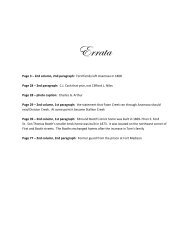Anamosa - A Reminiscence 1838 - 1988
The definitive history of the community of Anamosa, Iowa, USA
The definitive history of the community of Anamosa, Iowa, USA
Create successful ePaper yourself
Turn your PDF publications into a flip-book with our unique Google optimized e-Paper software.
make the initial trip over the new road. A new<br />
passenger car was brought in and the train pulled out of<br />
<strong>Anamosa</strong> about seven o'clock in the evening of<br />
December 20. 1904, with J.F. Reed at the throttle;<br />
Charles Corwin as fireman; Joesph Ryan as conductor.<br />
The trip of 14 miles was made in an hour and six<br />
minutes, and the smoothness of the track was a<br />
surprise to everyone.<br />
The line of the old Davenport. Iowa 8: Dakota Railway<br />
was followed substantially except that the bluff region<br />
at Fremont was pierced to save the long route around it.<br />
There was about a mile of heavy rock work done in the<br />
bluff region at Fremont at a cost of $20,000. John Foley<br />
and Son handled their 20-mile contract to Coggon in<br />
the most satisfactory manner, using in the rock cuts<br />
40.000 pounds of powder and 25,000 pounds of<br />
dynamite. Mr. Foley also lost 35 head of mules building<br />
the two miles of roadbed at Fremont.<br />
When the train arrived at Prairieburg half a dozen<br />
sleds were waiting to take the pasengers up town. (The<br />
depot was located at the south edge of town because.<br />
with the town located on a hill, it would have needed<br />
too steep a grade for trains to ascend.) It was a lovely<br />
moonlit night and not too cold. The celebration was<br />
held in the school house. Thomas Abey was the master<br />
of ceremonies. Other speakers were Judge H.M.<br />
Remley. R.W. Stewart, Mr. Glasser, N.J. Benson.<br />
Mr.Gillilan, and E.R. Moore. Near midnight, Kiene<br />
shouted. "All aboard for <strong>Anamosa</strong>." three cheers were<br />
given, and the teams with their big sleds took on their<br />
loads for the train.<br />
On January 9. 1905. the laying of the rails was<br />
completed to Coggon, and the contractors and their<br />
men took a much needed rest, having worked day and<br />
night a good part of the season.<br />
At the <strong>Anamosa</strong> end of the line, the piling at<br />
Anderson's mill was rapidly progressing and the short<br />
stretch of grading between the mill and <strong>Anamosa</strong> was<br />
nearly completed. The depot was to be erected not far<br />
from the Lehman place (where the Roland Browns live<br />
now) just southwest ofthe reformatory.<br />
On January 24. 1905, General Manager John<br />
Wunderlich. Chief Engineer J.F.Lacock, Attorney J .E.<br />
Remley, and a half dozen others, left <strong>Anamosa</strong> for<br />
Coggon. It was a bitter cold day and this side of<br />
Prairieburg, the snow drifts brought everthing to a<br />
standstill: they could go no further, nor could they<br />
return. All hands were obliged to shovel snow into the<br />
tender to keep up a supply of water, and the night was<br />
passed under the hospitable roof of Mr. Neely. The<br />
intention of this trip was to give attention to the<br />
installation of a switch at Prairieburg and to return with<br />
six carloads of livestock from Coggon and Prairieburg.<br />
In the latter part of April 1905, C.L. Niles sold his<br />
stock in the C.A.& N. Ry. to Henry I-(iene, of Dubuque.<br />
This gave Kiene complete control of the enterprise. On<br />
Sunday. June 4 1905, the "CAN"ran excursion trains<br />
as follows: They left <strong>Anamosa</strong> at 9 a.m., 12:30 p.m., 4<br />
p.m.; and left Coggon at 10:50 a.m., 2:20 p.m. and 5:35<br />
p.m. Fares were 25 cents for adults and 15 cents for<br />
children. This fare applied from any station to any<br />
other station on the line and return. Trains in <strong>Anamosa</strong><br />
departed from the Chicago Northwestern depot. Stops<br />
were made at the picturesque rock cuts at Fremont as<br />
well as the picnic grounds at Jackson. Anderson, and<br />
McQueen's Grove. In August of 1905, the "CAN"<br />
railway completed their connection with the Milwaukee<br />
Road and started using the Milwaukee depot in<br />
<strong>Anamosa</strong> instead of the Chicago Northwestem depot.<br />
The C.A.& N. was completed to Quasqueton. but they<br />
never got a bridge built across the Wapsipinicon River<br />
at Quasqueton, so they could continue the railroad to<br />
Waterloo. The towns and stations served by the<br />
railroad were: <strong>Anamosa</strong>. Fremont, Jackson, Anderson,<br />
Prairieburg, Coggon, Robinson, Kiene, and<br />
Quasqueton.<br />
President Kiene managed to keep the “CAN "<br />
operating until 1917, when the United States entered<br />
World War I; but the war is what ended the little 20-<br />
mile railroad. It was not needed to handle war goods<br />
and was, therefore, not a priority. In a short time<br />
thereafter, the equipment was sold and the rails and<br />
steel bridges were taken up and went for scrap or for<br />
use on other railroads to help the war effort.<br />
.- I-_=-':<br />
I<br />
-ll<br />
Al‘ do ‘<br />
F<br />
r'.Pr"



